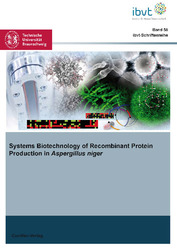| Fachbereiche | |
|---|---|
| Buchreihen (96) |
1378
|
| Nachhaltigkeit |
3
|
| Gesundheitswesen |
1
|
| Geisteswissenschaften |
2364
|
| Naturwissenschaften |
5406
|
| Mathematik | 229 |
| Informatik | 319 |
| Physik | 980 |
| Chemie | 1363 |
| Geowissenschaften | 131 |
| Humanmedizin | 243 |
| Zahn-, Mund- und Kieferheilkunde | 10 |
| Veterinärmedizin | 108 |
| Pharmazie | 147 |
| Biologie | 835 |
| Biochemie, Molekularbiologie, Gentechnologie | 121 |
| Biophysik | 25 |
| Ernährungs- und Haushaltswissenschaften | 45 |
| Land- und Agrarwissenschaften | 1004 |
| Forstwissenschaften | 201 |
| Gartenbauwissenschaft | 20 |
| Umweltforschung, Ökologie und Landespflege | 148 |
| Ingenieurwissenschaften |
1793
|
| Allgemein |
98
|
|
Leitlinien Unfallchirurgie
5. Auflage bestellen |
|
Erweiterte Suche
Systems Biotechnology of Recombinant Protein Production in Aspergillus niger (Band 58)
Habib Driouch (Autor)Vorschau
Inhaltsverzeichnis, Datei (160 KB)
Leseprobe, Datei (210 KB)
The filamentous fungus Aspergillus niger is an important efficient microbial cell factory for industrial production of enzymes as well as organic acids or antibiotics. In submerged cultivation, A. niger exhibits a rather complex morphology which typically has a strong influence on production performance. Although difficult to control so far, the morphological shape is obviously linked to key production characteristics of fungal cell factories.
In this regard, comprehensive approaches, combining systems wide analysis and optimization at the cellular level with process driven engineering of the bioreactor environment, seem most useful in order to achieve superior production processes. This was applied to recombinant proteins production in A. niger. The optimization included the use of talc or alumina micro particles, added to the culture, which allowed to the precise controlling the morphological shape of A. niger and increase enzyme production in different recombinant strains. Additionally, the targeted engineering of the morphology of A. niger into high-producing bio-pellet forms of various sizes by the addition of titanate micro particles was demonstrated. This strategy was combined with model-based medium design and development of efficient fed-batch strategies to optimize the production of the high-value enzyme fructofuranosidase, an important biocatalyst for neo-sugar in food or pharmaceutical industry, in the recombinant strain A. niger SKAn1015. As a result, the achieved enzyme titre could be increased to 2,800 U/mL, more than tenfold as compared to previously described processes. The enzyme, obtained by this micro particle enhanced process, could be applied as biocatalyst with minimal pre-treatment for the biosynthesis of 450 g/L of neo-sugar of the inulin type, such as 1 kestose and 1 nystose, which all display pre-biotics with substantial commercial interest.
These studies were complementary by systems biotechnology analysis of A. niger as it is expected that this may lead to increased understanding of the context of cellular metabolism, regulation and thus further improvement of strains and processes. Fluxome analyses by 13C isotope studies and in silico design are applied to quantify the underlying carbon core metabolism of A. niger under different conditions. This yielding valuable insights towards the tailor made design of A. niger as a cell factory for recombinant protein production.
| ISBN-13 (Printausgabe) | 3869558083 |
| ISBN-13 (Printausgabe) | 9783869558080 |
| ISBN-13 (E-Book) | 9783736938083 |
| Buchendformat | A5 |
| Sprache | Englisch |
| Seitenanzahl | 192 |
| Umschlagkaschierung | matt |
| Auflage | 1 Aufl. |
| Buchreihe | Schriftenreihe des Institutes für Bioverfahrenstechnik der Technischen Universität Braunschweig |
| Band | 58 |
| Erscheinungsort | Göttingen |
| Promotionsort | TU Braunschweig |
| Erscheinungsdatum | 11.07.2011 |
| Allgemeine Einordnung | Dissertation |
| Fachbereiche |
Biologie
Biochemie, Molekularbiologie, Gentechnologie |
| Schlagwörter | Aspergillus niger, Morphologie-Engineering, Submerskultivierung, Mickropartikeln, Biopellet Design, Medium Design, Bioprozessoptimierung, rekombinant Protein Produktion, Fructofuranosidase, Glucoamylase, Green Fluorescent Protein, Fructooligosaccharide, in silico-Design, Metabolische Netzwerkanalyse, Elementarmoden-Analyse, Amplifizierungs Target, Attenuations Target, 13C Metabolische Flussanalyse, Systembiotechnologie, Metabolic Engineering |








